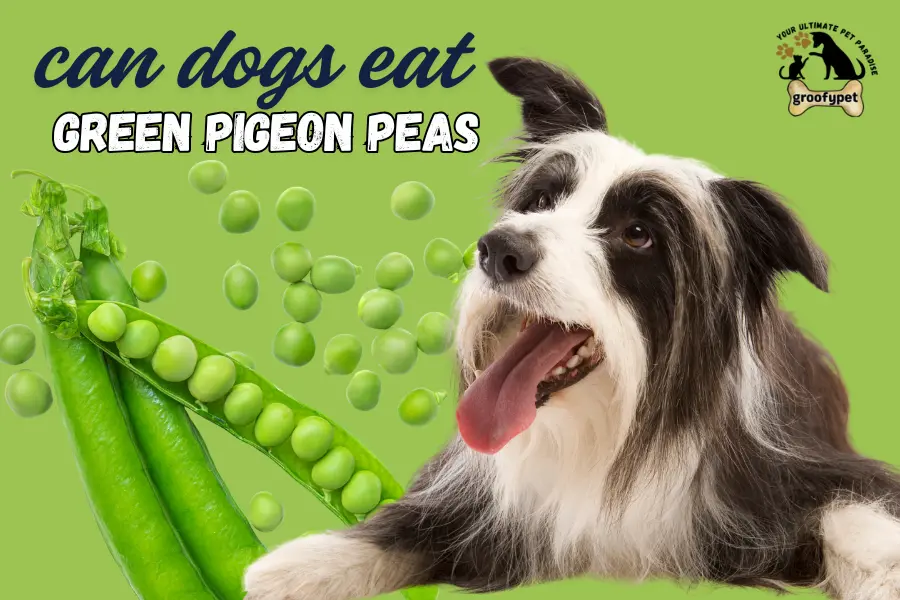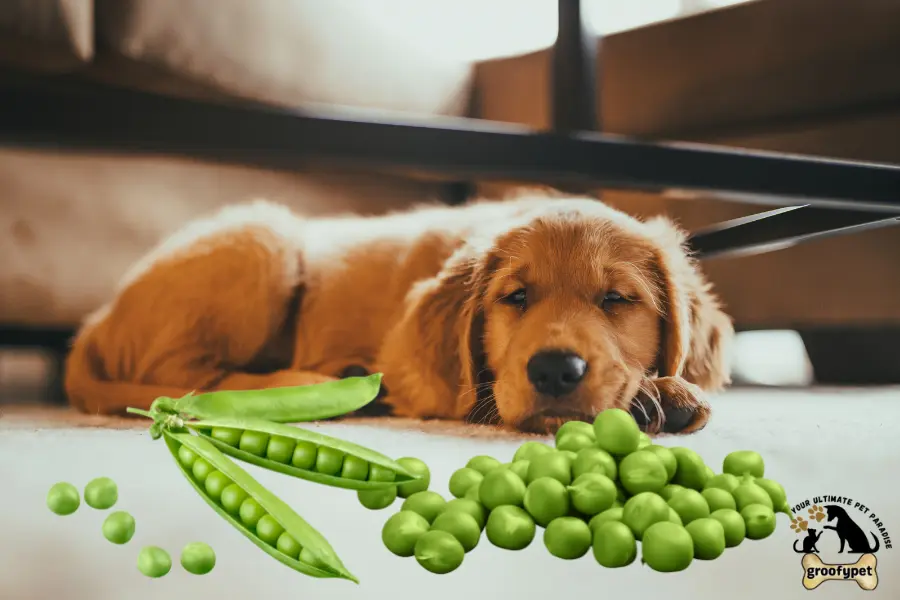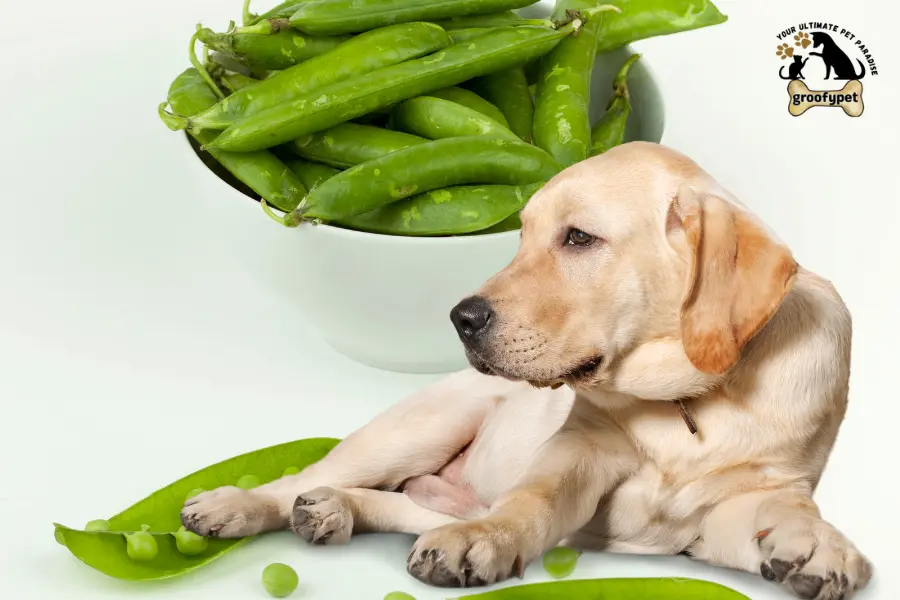
Green pigeon peas are small, round, green legumes that many people enjoy in meals. They are common in many parts of the world and are healthy for humans. Can dogs eat green pigeon peas?Dog owners think about how they safely feed these peas to their pets. Feeding dogs human food will be tricky, and not all vegetables and legumes are safe. Knowing which foods are healthy and which cause problems is very important.
In this article we will discuss if dogs can eat green pigeon peas the benefits, risks and safe ways to feed them. You will also learn how to serve them properly and what to avoid. By the end you will have a full guide to help your dog enjoy this food safely. This guide uses simple words, clear steps and easy tips for all dog owners.
Yes dogs eat green pigeon peas in small amounts if prepared safely. They are not toxic but feeding them raw or with spices cause stomach problem. Dogs need plain, cooked peas without salt or oil. Green pigeon peas provide protein and fiber that help digestion.
Too many peas cause gas or diarrhea. Always introduce new foods slowly to see how your dog reacts. Keep peas as a treat, not a main meal. Moderation is the key to safe feeding. If your dog has some health issues, always check with your vet first.
People use them in soups, stews and rice dishes. For dogs they provide extra nutrition if cooked properly. They are low in fat and easy to digest when mashed or boiled. Many dog owners use them as a supplement to regular dog food. Knowing what they are and their nutrients helps you feed your dog safely.
Can dogs eat peas?
Yes, dogs can eat peas in general. Green peas, snow peas, and sugar snap peas are safe in moderation. They provide fiber, protein, and essential vitamins. Peas help with digestion, weight management, and energy. Avoid canned peas with salt or sugar.

Feed raw, cooked, or mashed peas. Introduce slowly to avoid stomach upset. Small dogs need smaller portions. Peas can be treats or mixed with dog food. Proper portioning keeps dogs healthy and happy.
Are green pigeon peas safe for dogs?
Green pigeon peas are safe if they are plain and cooked. Raw peas are hard to digest. Peas cooked with salt, oil or spices upset dog stomach. Always wash the peas before cooking. Boiling or steaming is the safest way. Introduce small portions first to check .
Dogs with sensitive stomachs should eat few peas at a time. Avoid canned peas with added salt or sugar. Safe feeding makes sure your dog enjoys the health benefits without problems.
Benefits of green pigeon peas for dogs
Green pigeon peas are healthy for dogs when fed in small amounts. They are a good source of protein, which helps build strong muscles.Green pigeon peas can help dogs in many ways. They are a good source of plant protein which helps build muscles.
1. Good source of protein
Green pigeon peas are rich in plant protein, which helps dogs build muscles. Protein is important for growth, repair, and energy. Dogs need protein for healthy skin, coat, and overall strength. Feeding peas occasionally adds extra protein to their diet.
This is especially useful for active dogs or those that need more nutrition. Protein from peas is easy to digest when cooked. Including peas supports daily health naturally.
2. Helps in digestion
Green pigeon peas are high in fiber, which helps the digestive system. Fiber prevents constipation and keeps the gut healthy. It helps dogs pass stool easily and supports regular bowel movements. Dogs with mild digestive issues can benefit from small portions.
Fiber also helps maintain healthy gut bacteria. Cooking peas makes fiber gentle on the stomach. This benefit makes peas a healthy treat for all ages.
3. Low in fat
Green pigeon peas are naturally low in fat, which helps maintain a healthy weight. Overweight dogs can have peas as a low-calorie snack. Low fat reduces stress on the heart and joints.
It also prevents weight gain when used as a treat. Paired with a balanced diet, peas can improve overall health. Feeding plain, cooked peas keeps fat levels safe.
4. Provides essential vitamins and minerals
Green pigeon peas contain vitamins like B-complex and minerals like iron and magnesium. These nutrients boost energy, immunity, and overall health. They help maintain strong bones, muscles, and a healthy heart.
Vitamins in peas also support metabolism. Dogs with minor nutrient deficiencies may benefit from small portions. Cooking preserves most nutrients. This makes peas a simple supplement to their meals.
5. Helps with weight management
The combination of fiber, protein, and low fat helps dogs feel full without adding calories. Dogs eat fewer snacks and feel satisfied. This is helpful for overweight or less active dogs. Fiber slows digestion, which keeps dogs from getting hungry too quickly.
Peas can replace high calorie treats. They are a natural, safe way to manage weight. Regular portion control ensures long-term benefits.
They are also good for dogs with mild constipation due to the fiber. Including peas occasionally can make meals nutritious. Always serve them cooked and plain.
Risks of green pigeon peas for dogs
Green pigeon peas have some risks if not fed properly.
1. Gas and bloating
Feeding too many peas can cause gas and bloating. Dogs’ stomachs may react to high fiber quickly. Gas can make your dog uncomfortable and restless. Small portions help reduce this risk. Gradually introduce peas to avoid sudden digestive issues. Monitor your dog after first servings. Cooking peas properly can also reduce bloating.
2. Stomach upset or diarrhea
Raw or overfed peas can cause stomach upset or diarrhea. Dogs may vomit or have soft stools. Sensitive dogs are more at risk. Introduce small amounts first. Cooking peas softens them for easier digestion. Avoid feeding peas as a main meal. This ensures your dog’s stomach remains healthy.
3. Choking hazard
Whole or raw peas can be hard to chew, especially for small dogs. This increases the risk of choking. Always mash or cook peas for small dogs. Watch while they eat. Avoid feeding frozen or dry peas. Proper preparation keeps feeding safe.
4. Allergic reactions
Some dogs may be allergic to legumes, including pigeon peas. Signs include itching, rashes, vomiting, or diarrhea. Allergies are rare but possible. Stop feeding immediately if symptoms appear. Consult a vet for severe reactions. Small initial portions can help detect sensitivity.
5. Problems with canned or seasoned peas
Canned peas often contain salt, sugar, or preservatives, which can be harmful. Seasoned peas with oil, butter, or spices can upset the stomach. Feeding these increases risk of vomiting, diarrhea, or long-term health issues. Always feed fresh, plain, cooked peas. Proper preparation avoids unnecessary risks.
Overfeeding peas can reduce appetite for regular dog food. Always feed in moderation and monitor your dog reaction. Safety is the priority.
how to serve green pigeon peas to dogs
Safe cooked peas
Cooked peas are the safest way to feed dogs. Boil or steam them until soft. Avoid adding salt, oil, butter or spices. Mash them slightly for smaller dogs. Mixing them with regular dog food makes meals enjoyable. Cooked peas retain most nutrients and are easy to digest.
Store leftovers in the fridge for a day or two. Avoid giving frozen peas directly without cooking. Serve at room temperature to prevent stomach upset. This method ensures your dog gets the benefits safely.
How much is safe?
Small dogs should eat 2 to 3 peas at a time. Medium dogs can have 4 to 6 peas. Large dogs eat 6 to 10 peas in a serving. Feed only a few times per week as a treat. Introduce peas slowly to avoid stomach upset.
Watch for gas, diarrhea, or vomiting after the first servings. If your dog tolerates them well, you gradually increase a bit. Never replace regular dog food with peas. Always keep portions controlled for safe feeding
Can puppies eat green pigeon peas?
- Puppies have delicate digestive systems, so caution is needed.
- Small amounts of plain, cooked green pigeon peas are safe.
- Avoid raw or seasoned peas.
- Introduce them slowly to see if your puppy tolerates them.
- Peas provide fiber and protein that can help growth.
- Avoid giving too many peas because it can cause diarrhea.
- Mash the peas for easier chewing.
- Keep treats like peas separate from main meals.
- Moderation is very important for puppies’ health.
- Always consult a vet if unsure.
Can dogs be allergic to green pigeon peas?
Some dogs may have allergies to legumes. Signs include itching, skin rashes, vomiting, or diarrhea. Allergic reactions are rare but possible. Stop feeding immediately if you notice symptoms. Give your dog plain water and monitor closely.
Mild reactions may pass, but severe reactions need vet care. Introduce peas in very small amounts to check tolerance. Keep a record of any foods that cause reactions. Safety comes first when introducing new foods.
What to do if your dog eats too many green pigeon peas?
- Eating too many peas can cause stomach upset, gas, or diarrhea.
- Monitor your dog for vomiting or bloating.
- Offer plain water to help digestion.
- Small dogs are more sensitive than large dogs.
- If symptoms persist, contact your vet.
- Do not induce vomiting unless instructed by a professional.
- Keep a safe portion in future feedings.
- Prevention is better than treatment.
- Learning safe limits protects your dog health.
Can dogs eat green pigeon peas?Better alternatives to green pigeon peas
Some vegetables are safer for dogs than pigeon peas. Green peas are easy to digest and safe in small portions. Carrots are good for teeth and low-calorie snacks. Pumpkin helps with digestion and constipation. Sweet potatoes provide fiber and vitamins.

Serve all alternatives cooked and plain. Avoid added salt or spices. These vegetables are excellent for treats with dog food. They replace pigeon peas if your dog does not tolerate them. Variety keeps meals healthy and interesting.
Can dogs eat green snap peas?
Yes, dogs can eat green snap peas in small amounts. These peas are safe when raw or cooked, but avoid adding salt, oil, or spices. They are crunchy and provide fiber and protein, which help digestion. Snap peas also have vitamins that support immunity and energy.
Wash them well before feeding. Small dogs need fewer peas, while larger dogs can have more. Introduce snap peas slowly to see if your dog likes them. Avoid giving too many at once to prevent gas or diarrhea. Snap peas can be a healthy treat when served correctly.
Can dogs eat green peas?
Green peas are safe for dogs in moderation. They are full of fiber, protein, and vitamins, which help dogs stay healthy. You can feed them raw, cooked, or mashed. Avoid canned green peas with added salt or sugar. Peas help with digestion.
keep the stomach healthy, and are low in calories. They can also help manage weight in overweight dogs. Always feed a few at a time. Watch for gas or diarrhea after the first servings. Green peas are a safe, nutritious treat for dogs of all ages.
Green peas is good for dogs
Yes, green peas are good for dogs. They are low in calories and high in fiber and protein. Peas help digestion and keep the gut healthy. They also contain vitamins like A, C, and K which support immunity and bones. Small dogs need a few peas, while large dogs can eat more.
Peas can be raw or cooked but avoid canned peas with salt. They make a healthy treat and can be mixed with dog food. Moderation is key to prevent stomach upset. Dogs can enjoy peas safely if fed correctly.
Green peas for dogs
Green peas are safe and healthy for dogs. They are easy to digest and provide nutrients for energy, growth, and immunity. Dogs enjoy the taste and crunch. Feed plain, cooked, or mashed peas. Avoid adding oil, salt, or spices.
Peas can be mixed with dog food or given as a treat. Watch for gas or bloating at first. Peas are low in fat and help maintain healthy weight. They also support heart and digestive health. Green peas are one of the safest legumes for dogs.
How to use green pigeon peas?
- Green pigeon peas should be boiled or steamed until soft.
- Avoid salt, oil, or spices. You can mash them for small dogs.
- Mix with dog food or feed as a small treat.
- Introduce slowly to see if your dog tolerates them.
- Do not feed raw peas as they are hard to digest.
- Cooked peas retain nutrients like protein, fiber, and vitamins.
- Use small portions for puppies and older dogs.
- Peas can be frozen after cooking and reheated gently.
- Proper use ensures safe and healthy feeding.
Can dogs eat canned pigeon peas?
Canned pigeon peas are not recommended for dogs. Most have added salt or preservatives that can harm dogs. If you must feed them, rinse thoroughly and cook again. Always give in very small portions. Prefer fresh or dried pigeon peas boiled plain.
Canned peas often cause stomach upset or diarrhea. Feeding canned peas regularly is unsafe. Dogs digest cooked fresh peas better. Always check the ingredients before giving any canned food to your dog. Plain boiled peas are the safest choice.
Can dogs eat green pigeon peas raw?
Dogs should not eat green pigeon peas raw. Raw peas are hard and difficult to digest. They can cause stomach upset, gas, or diarrhea. Small pieces may also be a choking hazard especially for small dogs or puppies. Cooking peas softens them and makes nutrients easier to absorb.
Always boil or steam peas before feeding your dog. Raw peas do not provide as much benefit as cooked ones. Safety comes first, so always prepare peas properly.
Can dogs eat green pigeon peas raw or cooked?
Dogs can safely eat cooked green pigeon peas. Cooking makes them soft and easy to digest. You can boil or steam peas without salt, oil, or spices. Raw peas are not recommended because they are hard and may upset the stomach.

Cooked peas provide protein, fiber, and vitamins, which support digestion, energy, and overall health. Serve small portions first to see how your dog reacts. Mixing peas with regular dog food makes them more enjoyable. Always prioritize plain, cooked peas for safety.
Can dogs eat green pigeon peas everyday?
Dogs should not eat green pigeon peas every day. Peas are healthy in moderation, but too much can cause gas, bloating, or diarrhea. Feeding peas a few times a week as a treat is safe. Dogs need a balanced diet with protein from meat or dog food as the main source.
Peas can be a small supplement to their regular meals. Overfeeding can reduce appetite for essential dog food. Introduce them slowly and watch for digestive issues. Moderation ensures peas are safe and beneficial.
Frequently Asked Questions
Can dogs eat frozen green pigeon peas?
Yes if they are cooked first. Frozen peas are hard and cold, which can upset the stomach. Boil or steam before feeding.
Can dogs eat canned green pigeon peas?
Not recommended. Most canned peas have added salt or preservatives. Rinse well and cook if you must give a small portion.
Can dogs eat dry green pigeon peas?
No Dry peas are very hard and can cause choking. Always cook before feeding.
Are green pigeon peas toxic to dogs?
No they are not toxic. Problems arise only if they are raw, overfed, or cooked with spices and salt.
Can senior dogs eat green pigeon peas?
Yes in small soft portions. Avoid raw peas, and feed them cooked and mashed. Watch for digestive issues.
Final Thoughts
Green pigeon peas can be a safe and healthy treat for dogs if served correctly. Cooked, plain peas provide protein, fiber, and essential nutrients. Overfeeding or adding spices can cause stomach upset. Puppies, seniors, and dogs with sensitive digestion need extra caution.
Always feed in moderation and observe your dog’s reaction. Safe serving methods and small portions make peas a nutritious addition. Using alternatives like carrots, pumpkin, or sweet potato can add variety. Following these tips keeps your dog healthy and happy while enjoying a new food.
Can Dogs Eat Cottage Cheese with Pineapple? The Delicious Treat Your Pup Will Love!
Cucumber Water for Dogs: The Simple Drink That Brings Big Health Smiles!



